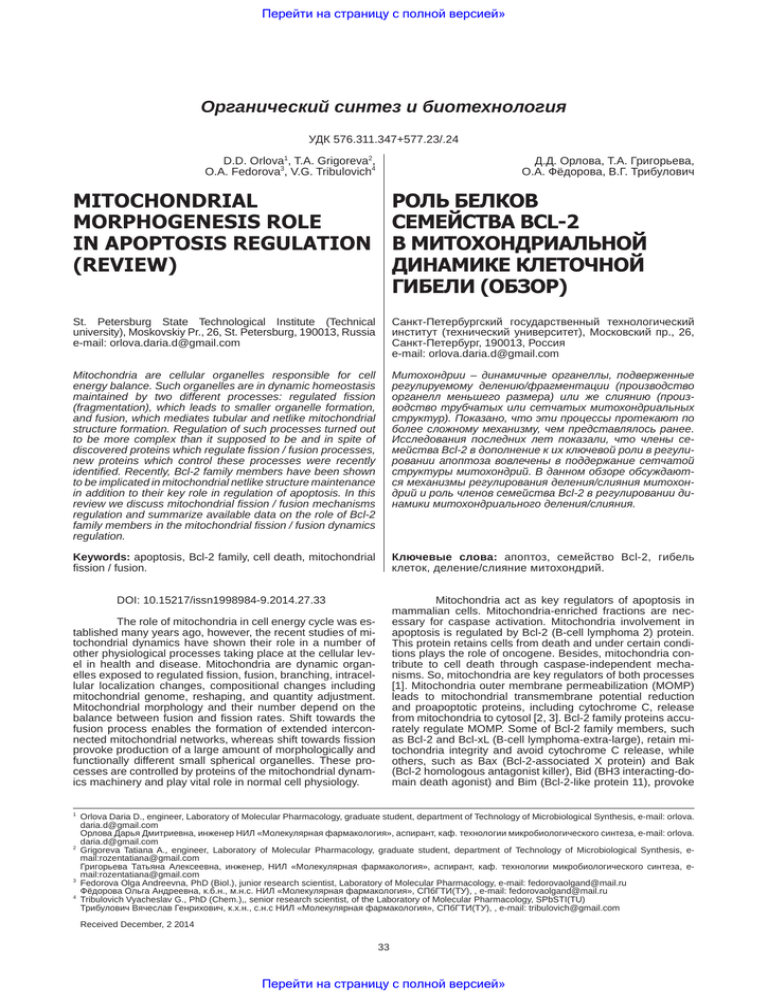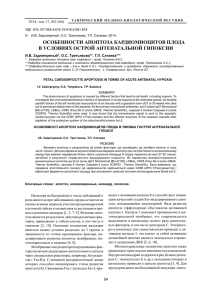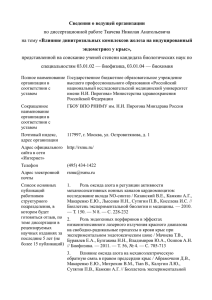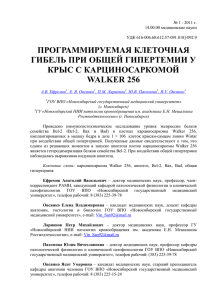роль белков семейства bcl-2 в митохондриальной динамике
advertisement

Copyright ОАО «ЦКБ «БИБКОМ» & ООО «Aгентство Kнига-Cервис» Перейти на страницу с полной версией» Органический синтез и биотехнология УДК 576.311.347+577.23/.24 1 D.D. Orlova , T.A. Grigoreva2, O.A. Fedorova3, V.G. Tribulovich4 Д.Д. Орлова, Т.А. Григорьева, О.А. Фёдорова, В.Г. Трибулович MITOCHONDRIAL MORPHOGENESIS ROLE IN APOPTOSIS REGULATION (REVIEW) РОЛЬ БЕЛКОВ СЕМЕЙСТВА BCL-2 В МИТОХОНДРИАЛЬНОЙ ДИНАМИКЕ КЛЕТОЧНОЙ ГИБЕЛИ (ОБЗОР) St. Petersburg State Technological Institute (Technical university), Moskovskiy Pr., 26, St. Petersburg, 190013, Russia e-mail: orlova.daria.d@gmail.com Санкт-Петербургский государственный технологический институт (технический университет), Московский пр., 26, Санкт-Петербург, 190013, Россия e-mail: orlova.daria.d@gmail.com Mitochondria are cellular organelles responsible for cell energy balance. Such organelles are in dynamic homeostasis maintained by two different processes: regulated fission (fragmentation), which leads to smaller organelle formation, and fusion, which mediates tubular and netlike mitochondrial structure formation. Regulation of such processes turned out to be more complex than it supposed to be and in spite of discovered proteins which regulate fission / fusion processes, new proteins which control these processes were recently identified. Recently, Bcl-2 family members have been shown to be implicated in mitochondrial netlike structure maintenance in addition to their key role in regulation of apoptosis. In this review we discuss mitochondrial fission / fusion mechanisms regulation and summarize available data on the role of Bcl-2 family members in the mitochondrial fission / fusion dynamics regulation. Митохондрии – динамичные органеллы, подверженные регулируемому делению/фрагментации (производство органелл меньшего размера) или же слиянию (производство трубчатых или сетчатых митохондриальных структур). Показано, что эти процессы протекают по более сложному механизму, чем представлялось ранее. Исследования последних лет показали, что члены семейства Bcl-2 в дополнение к их ключевой роли в регулировании апоптоза вовлечены в поддержание сетчатой структуры митохондрий. В данном обзоре обсуждаются механизмы регулирования деления/слияния митохондрий и роль членов семейства Bcl-2 в регулировании динамики митохондриального деления/слияния. Keywords: apoptosis, Bcl-2 family, cell death, mitochondrial fission / fusion. Ключевые слова: апоптоз, семейство Bcl-2, гибель клеток, деление/слияние митохондрий. DOI: 10.15217/issn1998984-9.2014.27.33 Mitochondria act as key regulators of apoptosis in mammalian cells. Mitochondria-enriched fractions are necessary for caspase activation. Mitochondria involvement in apoptosis is regulated by Bcl-2 (B-cell lymphoma 2) protein. This protein retains cells from death and under certain conditions plays the role of oncogene. Besides, mitochondria contribute to cell death through caspase-independent mechanisms. So, mitochondria are key regulators of both processes [1]. Mitochondria outer membrane permeabilization (MOMP) leads to mitochondrial transmembrane potential reduction and proapoptotic proteins, including cytochrome C, release from mitochondria to cytosol [2, 3]. Bcl-2 family proteins accurately regulate MOMP. Some of Bcl-2 family members, such as Bcl-2 and Bcl-xL (B-cell lymphoma-extra-large), retain mitochondria integrity and avoid cytochrome C release, while others, such as Bax (Bcl-2-associated X protein) and Bak (Bcl-2 homologous antagonist killer), Bid (BH3 interacting-domain death agonist) and Bim (Bcl-2-like protein 11), provoke The role of mitochondria in cell energy cycle was established many years ago, however, the recent studies of mitochondrial dynamics have shown their role in a number of other physiological processes taking place at the cellular level in health and disease. Mitochondria are dynamic organelles exposed to regulated fission, fusion, branching, intracellular localization changes, compositional changes including mitochondrial genome, reshaping, and quantity adjustment. Mitochondrial morphology and their number depend on the balance between fusion and fission rates. Shift towards the fusion process enables the formation of extended interconnected mitochondrial networks, whereas shift towards fission provoke production of a large amount of morphologically and functionally different small spherical organelles. These processes are controlled by proteins of the mitochondrial dynamics machinery and play vital role in normal cell physiology. 1 Orlova Daria D., engineer, Laboratory of Molecular Pharmacology, graduate student, department of Technology of Microbiological Synthesis, e-mail: orlova. daria.d@gmail.com Орлова Дарья Дмитриевна, инженер НИЛ «Молекулярная фармакология», аспирант, каф. технологии микробиологического синтеза, e-mail: orlova. daria.d@gmail.com 2 Grigoreva Tatiana A., engineer, Laboratory of Molecular Pharmacology, graduate student, department of Technology of Microbiological Synthesis, email:rozentatiana@gmail.com Григорьева Татьяна Алексеевна, инженер, НИЛ «Молекулярная фармакология», аспирант, каф. технологии микробиологического синтеза, email:rozentatiana@gmail.com 3 Fedorova Olga Andreevna, PhD (Biol.), junior research scientist, Laboratory of Molecular Pharmacology, e-mail: fedorovaolgand@mail.ru Фёдорова Ольга Андреевна, к.б.н., м.н.с. НИЛ «Молекулярная фармакология», СПбГТИ(ТУ), , e-mail: fedorovaolgand@mail.ru 4 Tribulovich Vyacheslav G., PhD (Chem.),, senior research scientist, of the Laboratory of Molecular Pharmacology, SPbSTI(TU) Трибулович Вячеслав Генрихович, к.х.н., с.н.с НИЛ «Молекулярная фармакология», СПбГТИ(ТУ), , e-mail: tribulovich@gmail.com Received December, 2 2014 33 Перейти на страницу с полной версией»



